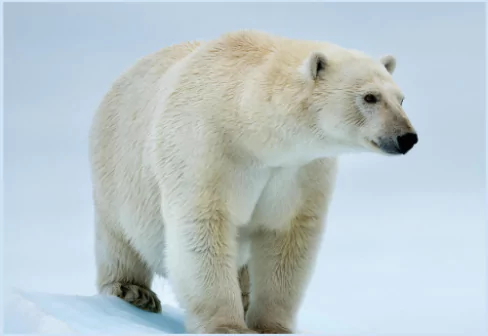A recent study has revealed that the fur of polar bears contains a unique oily substance that helps them stay dry even when sliding on ice or diving into water.
Significance of the discovery
- This discovery could inspire the development of sustainable alternatives to Per- and polyfluoroalkyl substances (PFAs), commonly known as “forever chemicals”.
Enroll now for UPSC Online Course
Key Findings of the Study
- Oily Substance in Polar Bear Fur: The oily substance, called sebum, is secreted by the skin of polar bears.
- It helps repel water and ice, keeping the bears dry and insulated in their icy Arctic habitat.
- Polar bear’s sebum did not contain squalene, a fatty oil commonly found in the hair of humans, sea otters, and many aquatic mammals.
- Comparison to PFAs: The properties of polar bear sebum are similar to those of PFAs, which are widely used in products like nonstick cookware, water-repellent clothing, and stain-resistant fabrics.
- Unlike PFAs, polar bear sebum is natural and environmentally friendly.
- Potential Applications: The study suggests that polar bear sebum could inspire the creation of eco-friendly coatings for industrial and consumer products.
- This could reduce the reliance on harmful PFAs and promote sustainable manufacturing processes.
About Per- and Polyfluoroalkyl Substances (PFAs)

- PFAs are synthetic chemicals known as “forever chemicals” because they do not break down easily and persist in the environment for long periods.
- Example: Perfluorooctane sulfonic acid (PFOS).
- They are used in a wide range of products, including nonstick cookware, waterproof clothing, cosmetics, and firefighting foams.
Environmental and Health Concerns of PFAs
- PFAs can migrate into soil, water, and air during production and use.
- They accumulate in the bodies of humans and animals, leading to serious health issues such as decreased fertility, developmental problems in children, and other long-term effects.
Implications of the Study
- Sustainable Alternatives to PFAs: The unique properties of polar bear sebum could lead to the development of natural, biodegradable coatings to replace PFAs in various industries.
- This would reduce environmental pollution and health risks associated with “forever chemicals.”
- Promoting Eco-Friendly Manufacturing: By mimicking the natural water-repellent properties of polar bear fur, industries can adopt more environmentally conscious practices.
Check Out UPSC Modules From PW Store
Polar Bears

- Polar bears, scientifically known as Ursus maritimus (meaning “sea bear”), are the largest bears in the world.
- They are skilled swimmers, capable of reaching speeds of six miles per hour, and have thick layers of fat and water-repellent fur to survive in freezing temperatures.
- Habitat and Distribution:
- Polar bears are found in the Arctic regions of Canada, Greenland/Denmark, Norway, Russia, and the United States (Alaska).
- They thrive in ice-covered waters and are more abundant in shallow areas associated with the continental shelf.
- Ecological Importance:
- As top predators, polar bears play a crucial role in maintaining the health of the Arctic marine ecosystem.
- They primarily hunt seals, which helps regulate seal populations and ensures a balanced food chain.
- Conservation Status:
- Polar bears are classified as Vulnerable by the International Union for Conservation of Nature (IUCN) due to threats like climate change, habitat loss, and pollution.
|
Ready to boost your UPSC 2025 preparation? Join PW’s UPSC online courses today!
![]() 1 Feb 2025
1 Feb 2025


